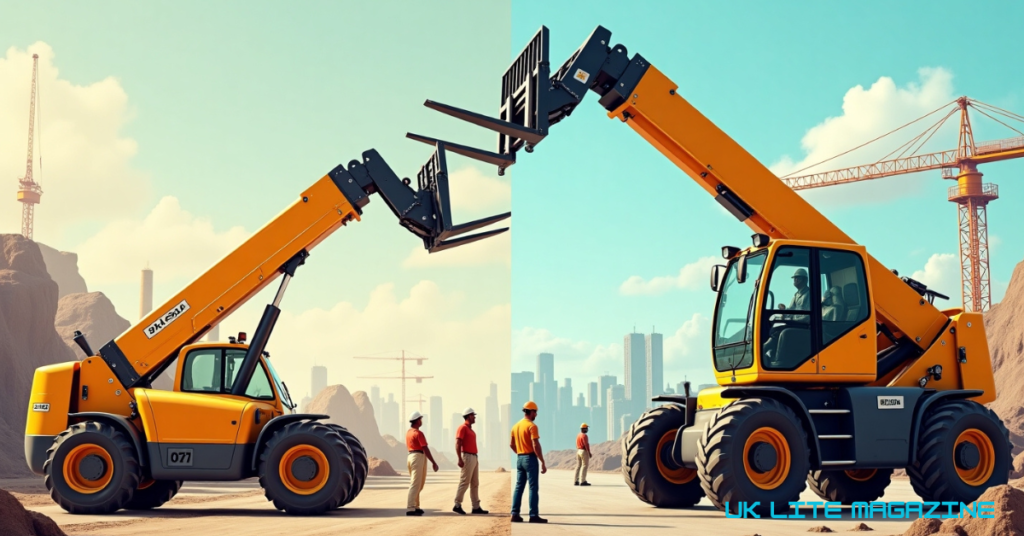Telescopic handler forklifts, often referred to as telehandlers, have been a game-changer in the construction, agriculture, and material handling industries. These versatile machines combine the features of a forklift with the extended reach of a crane, making them indispensable for various tasks. Let’s take a closer look at their journey, from their inception in 1957 to the advanced machines we see today.
The Birth of Telescopic Handler Forklifts in 1957
The story of telescopic handler forklifts began in 1957, a pivotal year in material handling innovation. During this period, manufacturers were experimenting with ways to enhance the efficiency of forklifts and cranes. The result was the creation of the first telehandler, which merged the lifting capability of a forklift with a telescopic boom. This innovation allowed operators to lift loads vertically and extend them forward, a revolutionary concept at the time.
These early models were simple in design, focusing primarily on functionality. They were equipped with basic hydraulic systems and could handle moderate loads. While they lacked the sophistication of today’s machines, their introduction marked the beginning of a new era in material handling.
Key Features of Early Telehandlers
- Hydraulic Boom: Early telehandlers featured a straightforward hydraulic boom, enabling limited reach and lift capacity.
- Compact Design: These machines were relatively small, making them suitable for confined spaces.
- Limited Attachments: Unlike modern telehandlers, the 1957 models were compatible with only a few attachments, such as forks or buckets.
- Manual Controls: Operators relied on basic manual controls, which required significant skill and precision.
Despite these limitations, the first telehandlers laid the groundwork for future advancements.
Advancements in the 1970s and 1980s
By the 1970s and 1980s, telehandlers underwent significant improvements. Manufacturers began incorporating advanced hydraulics, increasing the machines’ lifting capacity and reach. This period also saw the introduction of four-wheel drive and steering, which enhanced maneuverability on uneven terrain.
Key innovations included:
- Rotating Booms: Allowing for greater flexibility and improved load placement.
- Safety Features: Basic safety mechanisms, such as stabilizers, were added to improve stability during operation.
- Diverse Attachments: The ability to use attachments like grapples, augers, and work platforms increased the versatility of telehandlers.
These advancements made telehandlers a preferred choice in industries like agriculture, where they were used for tasks such as hay stacking and grain handling.
Technological Breakthroughs in the 1990s and Early 2000s
The 1990s marked a turning point for telehandlers, with manufacturers focusing on automation and operator comfort. Innovations during this era included:
- Enclosed Cabs: Operators could work comfortably in air-conditioned cabs, regardless of weather conditions.
- Advanced Hydraulics: Improved hydraulic systems allowed for smoother and more precise movements.
- Load Sensing Technology: Machines could now adjust hydraulic pressure based on the weight of the load, enhancing safety and efficiency.
- Digital Displays: Early digital interfaces provided real-time information on load weight, boom angle, and other critical parameters.
By the early 2000s, telehandlers had become indispensable for heavy-duty tasks in construction and mining. Their ability to handle heavy loads with precision and reach previously inaccessible areas set them apart from traditional forklifts.
Modern Telescopic Handler Forklifts
Today’s telehandlers are marvels of engineering, boasting cutting-edge technology and unparalleled versatility. Key features of modern machines include:
- Telematics Systems: These systems allow operators to monitor performance metrics, track fuel consumption, and schedule maintenance remotely.
- Smart Attachments: Modern telehandlers can automatically recognize attachments and adjust their settings for optimal performance.
- Enhanced Safety Features: Advanced sensors and cameras provide a 360-degree view, reducing blind spots and improving workplace safety.
- Eco-Friendly Engines: Many manufacturers are focusing on sustainability by introducing hybrid and electric models that reduce emissions.
- Unmatched Reach and Capacity: With some models offering a reach of over 50 feet and a lifting capacity exceeding 10,000 pounds, modern telehandlers are equipped to handle the most demanding tasks.
Applications Across Industries
Telehandlers have found applications across a wide range of industries, including:
- Construction: For lifting heavy materials to high floors and placing beams or trusses.
- Agriculture: Moving hay bales, feeding livestock, and managing grain storage.
- Warehousing: Stacking pallets and loading goods onto trucks.
- Disaster Relief: Assisting in debris removal and rescue operations in disaster-hit areas.
Conclusion
From their humble beginnings in 1957 to the technologically advanced machines of today, telescopic handler forklifts have come a long way. Their evolution reflects a constant drive for innovation, with manufacturers striving to meet the changing needs of industries worldwide. As technology continues to advance, the future of telehandlers promises even greater efficiency, safety, and sustainability.
Frequently Asked Questions (FAQs)
1. What is the primary function of a telescopic handler forklift?
A telehandler combines the features of a forklift and a crane, allowing it to lift, move, and place loads at various heights and distances.
2. How have telehandlers improved over the years?
Telehandlers have evolved with advancements in hydraulics, safety features, digital interfaces, and eco-friendly engines, making them more efficient and versatile.
3. What industries benefit most from telehandlers?
Construction, agriculture, warehousing, and disaster relief are the primary industries where telehandlers are widely used.
4. What safety features do modern telehandlers offer?
Modern telehandlers include 360-degree cameras, load-sensing technology, stabilizers, and operator alerts to ensure safe operation.
5. Are there eco-friendly telehandlers available today?
Yes, many manufacturers offer hybrid and electric models that reduce emissions and promote sustainability.

